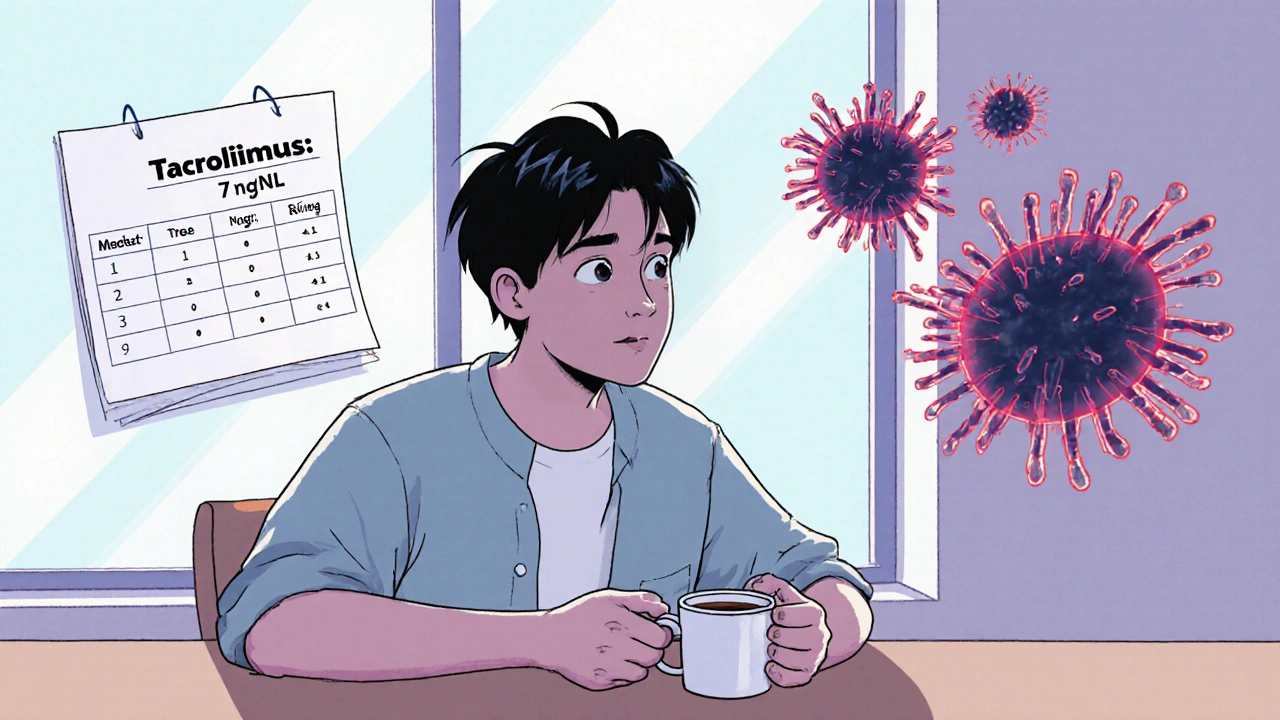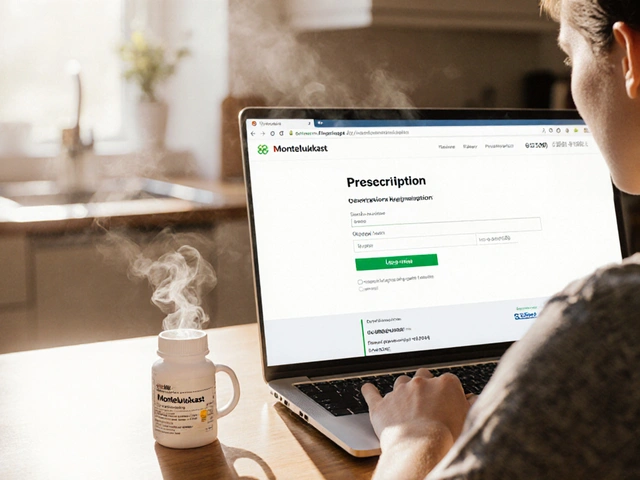
Tacrolimus Neurotoxicity Risk Calculator
Assess Your Neurotoxicity Risk
This tool estimates your risk of developing tacrolimus neurotoxicity based on key factors. Remember: this is an estimate, not a medical diagnosis.
When you’ve just had a transplant, the last thing you want is to feel like your body is betraying you. You’re taking tacrolimus to keep your new organ alive, but now your hands won’t stop shaking. Your head pounds like it’s being squeezed in a vice. You can’t sleep. You’re dizzy. And your doctor says your blood levels are "in range." So why do you feel so awful?
What Tacrolimus Neurotoxicity Really Feels Like
Tacrolimus is one of the most powerful immunosuppressants used after kidney, liver, heart, or lung transplants. It works by blocking your immune system from attacking the new organ. But it doesn’t just target your immune cells-it crosses into your brain. And when it does, it can cause a range of neurological side effects known as neurotoxicity.The most common sign? Tremor. About 65 to 75% of patients who experience neurotoxicity report uncontrollable shaking, usually in the hands. It’s not just a slight wiggle. People describe it as so bad they can’t hold a cup, button a shirt, or write their name. One patient on a transplant forum said, "I dropped my fork six times at dinner. I felt like I was 80 years old with Parkinson’s-and I was 34."
Headache is the second most frequent symptom. It’s not a typical tension headache. These are deep, constant, crushing pains that don’t respond to ibuprofen or acetaminophen. Many patients say they’ve never had headaches like this before-and they don’t go away until the tacrolimus dose is adjusted.
Other symptoms show up too: pins and needles in your fingers, trouble sleeping, confusion, even trouble speaking or swallowing. In rare but serious cases, patients develop Posterior Reversible Encephalopathy Syndrome (PRES), which shows up on MRI as swelling in the back of the brain. If missed, it can lead to seizures or stroke.
Why Your Blood Levels Don’t Tell the Whole Story
Doctors check tacrolimus blood levels all the time. The standard target range? 5 to 10 ng/mL for liver and heart transplants, 5 to 15 ng/mL for kidneys. But here’s the problem: neurotoxicity doesn’t always follow the numbers.A 2023 study found that 21.5% of patients with neurotoxicity had levels above 15 ng/mL. But-and this is critical-there was no statistically significant difference in average levels between patients who had symptoms and those who didn’t. In other words, someone with a level of 7 ng/mL might have terrible tremors, while someone else at 14 ng/mL feels fine.
Why? Because everyone’s brain handles tacrolimus differently. Some people have a genetic variation called CYP3A5*1 that makes them metabolize the drug faster. Others are slow metabolizers, meaning the drug builds up in their brain even at low doses. A 2021 study showed that testing for this gene before starting tacrolimus could cut neurotoxicity risk by 27%.
Even more surprising: brain chemistry matters. Low sodium, low magnesium, or dehydration can make your brain more sensitive to tacrolimus. One study found that correcting electrolyte imbalances alone resolved mild neurotoxicity in nearly 30% of cases-without touching the drug dose.
Who’s Most at Risk?
Not everyone gets neurotoxicity. But some groups are far more likely to.Liver transplant recipients have the highest risk-35.7% develop symptoms. Kidney transplant patients are next at 22.4%, then lung at 18.9%, and heart at 15.2%. Why? Liver transplants often involve more complex drug interactions, bigger doses, and patients who’ve been sicker longer. Their brains may already be more vulnerable.
Age also plays a role. Older patients are more likely to have symptoms. So are people with pre-existing nerve damage, diabetes, or high blood pressure. And if you’re on other drugs that affect the brain-like antibiotics (linezolid), sedatives (midazolam), or antipsychotics (olanzapine)-your risk jumps. These drugs can stack with tacrolimus like fuel on fire.
And here’s something many doctors still miss: symptoms often start early. Most patients report tremor or headache within the first 30 days after transplant. That’s the window when you need to be extra alert.
What Happens When You Have Symptoms?
The first step? Don’t panic-but don’t ignore it either. Many patients wait weeks before their symptoms are taken seriously. One survey found that 55% of people had to push their medical team before anyone connected the dots between their shaking and tacrolimus.Once identified, the usual fixes are:
- Lower the tacrolimus dose-even if levels are "in range."
- Switch to cyclosporine, another immunosuppressant with lower neurotoxicity risk (though it has a higher chance of rejecting the organ).
- Adjust electrolytes: fix sodium or magnesium if they’re low.
- Stop any other neurotoxic drugs if possible.
Most patients see improvement within 3 to 7 days after making a change. One patient reduced their dose from 0.1 mg/kg to 0.07 mg/kg and had their tremor vanish in 72 hours. Another switched to cyclosporine and said, "The headache lifted like someone turned off a light."
But there’s a catch: lowering tacrolimus or switching drugs increases the risk of organ rejection. Studies show rejection rates go up by 15 to 20% when switching from tacrolimus to cyclosporine. That’s why the decision isn’t made lightly. It’s a tightrope walk between protecting your brain and protecting your new organ.
What’s New in Managing This Problem?
The field is waking up. In 2023, the American Society of Transplantation released its first-ever guidelines specifically for managing tacrolimus neurotoxicity. They now recommend routine neurological checks in the first month after transplant.Biggest breakthrough? Genetic testing. Testing for CYP3A5 genotype is no longer just for research labs. Some transplant centers are starting to use it before prescribing tacrolimus. If you’re a slow metabolizer, they start you on a lower dose from day one. Early results show fewer tremors, fewer headaches, and fewer hospital visits.
Another promising approach? The TACTIC trial, which started in 2023, is testing a new algorithm that personalizes dosing based on your genes, your magnesium levels, and your blood pressure. The goal? Prevent neurotoxicity before it starts.
And on the horizon? A new drug called LTV-1. It’s designed to work like tacrolimus but can’t cross the blood-brain barrier as easily. Phase 2 trials began in 2023. If it works, it could replace tacrolimus as the go-to immunosuppressant by 2027.
What You Can Do Right Now
If you’re on tacrolimus and experiencing tremor, headache, or brain fog:- Track your symptoms daily. Note when they start, how bad they are, and if anything makes them better or worse.
- Ask your doctor to check your sodium and magnesium levels. Low levels can make neurotoxicity worse.
- Ask if you’ve been tested for CYP3A5 genotype. If not, request it.
- Review all your other medications. Are you on any antibiotics, sleep aids, or antipsychotics? Ask if they could be making things worse.
- Don’t wait for your next appointment. If symptoms are new or worsening, call your transplant team immediately.
Remember: your symptoms are real. Even if your blood level looks "normal," that doesn’t mean your brain is fine. You’re not overreacting. You’re paying attention-and that’s exactly what you should be doing.
What Comes Next?
Tacrolimus will stay the gold standard for transplants for years to come. It’s just too effective. But its neurotoxicity is no longer a side note-it’s a central challenge. The goal now isn’t just to keep organs alive. It’s to help people live well after transplant.That means doctors need to listen more. Patients need to speak up. And science needs to catch up with the reality of what this drug does to the brain.
For now, your best tools are awareness, communication, and asking the right questions. You’ve survived the transplant. Now it’s time to make sure the medicine doesn’t steal your quality of life.
Can tacrolimus cause tremors even if my blood level is in range?
Yes. While blood levels are used to guide dosing, neurotoxicity like tremor can occur even within the so-called "therapeutic range." Studies show that about 30% of patients with neurotoxic symptoms have tacrolimus levels that are technically normal. Individual differences in how the brain absorbs the drug, genetics, and other health factors play a bigger role than the blood number alone.
How long does it take for tremor and headache to go away after lowering tacrolimus?
Most patients see improvement within 3 to 7 days after reducing the dose or switching medications. Some report relief in as little as 24 to 48 hours, especially if electrolyte imbalances were also corrected. However, full recovery can take up to 2 weeks in more severe cases. Patience is key, but if symptoms worsen or new ones appear-like confusion or seizures-seek help immediately.
Is cyclosporine a safer alternative to tacrolimus for neurotoxicity?
Cyclosporine has a lower risk of neurotoxicity-about 15-20% less than tacrolimus. That’s why it’s often used as a switch when tremor or headache becomes unmanageable. But it comes with a trade-off: it’s less effective at preventing organ rejection. Studies show rejection rates rise by 15-20% when switching from tacrolimus to cyclosporine. The decision must balance brain health against organ survival.
Can low sodium or magnesium make tacrolimus neurotoxicity worse?
Absolutely. Low sodium (below 135 mmol/L) and low magnesium are well-documented risk factors. These electrolytes help stabilize nerve cell activity. When they’re low, your brain becomes more sensitive to tacrolimus-even at normal blood levels. Correcting these imbalances alone has resolved mild neurotoxicity in nearly 30% of cases, without changing the tacrolimus dose.
Should I ask for CYP3A5 genetic testing before starting tacrolimus?
Yes, especially if you’re getting a liver or kidney transplant. CYP3A5 is a gene that determines how fast your body breaks down tacrolimus. If you’re a slow metabolizer (CYP3A5*3/*3), you’re much more likely to build up toxic levels in your brain-even on a low dose. Testing before starting allows doctors to adjust your initial dose, reducing neurotoxicity risk by up to 27%. While not yet standard everywhere, it’s becoming more common in major transplant centers.
Are there any new drugs coming that won’t cause neurotoxicity?
Yes. A new drug called LTV-1 is currently in Phase 2 trials (as of 2025). It’s designed to block the immune system like tacrolimus but can’t cross the blood-brain barrier as easily, which means it’s much less likely to cause tremors, headaches, or brain swelling. If trials succeed, it could be approved by 2027 and become the next standard of care. Until then, managing tacrolimus carefully remains the best option.
Final Thoughts
Tacrolimus saved your life. But it shouldn’t steal your daily comfort. Tremor and headache aren’t just side effects-they’re signals. Your body is telling you something’s off. And in the world of transplant care, those signals matter more than ever.The old model-"if the level is in range, you’re fine"-is outdated. The future is personalized. Genetic testing. Electrolyte checks. Careful monitoring. And most of all, listening to the patient.
You’re not just a transplant recipient. You’re a person trying to live again. And you deserve a treatment plan that protects your body-and your brain.
13 Comments
Write a comment
More Articles

How to Buy Cheap Generic Singulair Online Safely in the UK
Learn how to safely buy cheap generic Singulair (montelukast) online in the UK, verify legit pharmacies, compare prices, and avoid counterfeit risks.

How and Where to Buy Eliquis Online in the UK (2025): Safe Options, Prices, Prescriptions
Need Eliquis online? Here’s how to buy it safely in the UK in 2025-where to order, prices, what prescription you need, delivery times, and red flags to avoid.
The Benefits of Exercise in Preventing Intestinal and Vaginal Infections
As a health enthusiast, I cannot emphasize enough the importance of exercise in our lives. Not only does it keep us in shape, but it also plays a crucial role in preventing intestinal and vaginal infections. By boosting our immune system, exercise helps our body to fight off harmful bacteria and maintain a healthy balance of good bacteria. Furthermore, physical activity aids in promoting proper blood circulation, which is essential for overall health and well-being. So, let's not neglect the power of exercise in keeping our bodies infection-free and healthy!
Gus Fosarolli
November 27, 2025 AT 20:16So my hands shake like I’m trying to high-five a ghost and my doctor says "it’s fine"? Cool. I’ll just keep dropping my coffee and pretending I’m a human metronome. At least my transplant’s working - my dignity? Not so much.